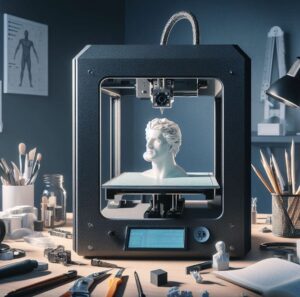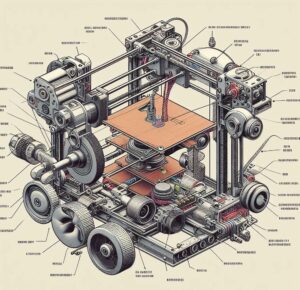A Dive into 3D Printing
The birth of 3D printing can be traced back to the late twentieth century, specifically the 1980s. This fascinating technology was initially developed with the aim of enhancing rapid prototyping processes. Rapid prototyping is an efficient and quick method to create a sample component or a model using 3D computer-aided design (CAD).
A couple of decades later, and the world witnesses an entirely transformed spectrum of 3D printing technology. Its growth has been exponential , it finds a home in more varied industries, reshaping them with its innovative approach. Its applications have expanded far beyond prototyping and into the actual production of end-use parts.
Among these industries, medicine stands as one of the most impacted sectors where 3D printing has created a real revolution. From creating patient-specific implants and prosthetics to bio printing living tissues for transplants and testing, 3D printers are revolutionizing healthcare services around the world. Several companies and research institutions are even aspiring to print functional human organs, presenting a new hope for organ transplant patients.
In the architectural realm, 3D printers are used to create detailed and highly accurate architectural models within hours, boosting efficiency while saving time and material. The technology has advanced far enough to construct entire buildings using large-scale 3D printers, championing sustainability and design flexibility.
What is a 3D Printer?

This advanced machine is designed to create tangible, three-dimensional objects from digital models or CAD files. The secret to this transformative feat lies in its unique method of fabrication – additive manufacturing. Unlike traditional manufacturing processes that rely on cutting or hollowing out materials, a 3D printer constructs objects by adding material layer upon layer – a procedure akin to assembling a loaf of sliced bread, slice by slice.
The realm of 3D printers encapsulates several types, each employing a distinct technology:
Fused Deposition Modeling (FDM): standing at the forefront as the most commonly used type of 3D printer, an FDM printer functionally transforms thermoplastic filament into molten form by heating it. The printer then extrudes this molten material through a nozzle, depositing it layer by layer along the X, Y, and Z axes to form the desired object. The usage of affordable raw materials, coupled with its relatively simplistic operation and maintenance, renders the FDM printer a popular choice among hobbyists and small business owners.
Stereolithography (SLA): venturing into a more precise, intricate domain is the SLA printer, which utilizes the particular properties of light-reactive resin. Pioneering the 3D printing industry, an SLA printer harnesses the power of a laser to convert liquid resin into solid forms. This method allows for the creation of objects with highly detailed features and smooth finish, making it highly suitable for industries such as dentistry, jewelry design, and prototyping where precision is key.
Selective Laser Sintering (SLS): the SLS printer employs a high-powered laser to sinter or coalesce powder-like material, such as nylon or polyamide, into the desired structure. The laser selectively targets and fuses the powdered material based on the design, layer by layer, until the 3D object takes shape. The ability of SLS printers to yield robust, complex geometries with no support structures needed set them apart, thus being frequently used in fields that require durable and functional parts like aviation, automotive, and manufacturing.
Breaking Down the 3D Printing Process
The 3D printing process is a multi-stage task embodying several critical steps. These stages ensure successful output and are crucial to the overall 3D printing journey.
The Design Stage is the first step of the 3D printing process. It involves the creation of a 3D model using CAD software where you can transform your digital concept into a virtual 3D representation. Alternatively, if you’re not a design enthusiast or lack the necessary skills, you can download pre-modeled designs from several online repositories. These designs are typically saved in an OBJ or STL format – the universally accepted formats for 3D printing.
After sculpting the design virtually, you’re required to convert it into a format that a 3D printer can comprehend. This necessitates slicing software, which bisects the 3D model into thousands of thin horizontal layers, allowing the printer to construct the object layer by layer. This software outputs a file typically in G-code format, instructing the printer on how to move, where to deposit material, the dimensions of each layer, and various other parameters.
Armed with the slicer’s blueprints, the 3D printer then dives into action, meticulously constructing the 3D object. Depending on the type of printer and the object’s complexity, this stage may take several hours to several days. The printer lays down each previously sliced layer one at a time according to the G-code instructions. As each layer solidifies, the next layer is added, eventually leading to the creation of the full-fledged 3D object.
Once the printer delivers the final product, the phase of refining the masterpiece begins. After the object has cooled down and solidified completely, it’s gently removed from the print bed. In many cases, some post-processing is required to achieve the desired aesthetic or functional properties. These may include removal of support structures, smoothening rough edges, painting, or applying a protective coating.
In all its essence, the procedure of 3D printing proves to be an intricate concert of design and technology, allowing imaginations to escape their digital confines and turn into tangible reality. Offering a synergistic blend of preparation, execution, and refinement, the 3D printing process is a testament to both technological prowess and creative genius.
Key Components of a 3D Printer

The components of a 3D printer interweave to represent a sophisticated design system. Here’s a detailed breakdown of these parts, each having their unique role and significance:
Aptly termed the ‘heart’ of the 3D printer, the extruder is instrumental in the formation of the object being printed. The extruder houses two main parts: the ‘hot end’ and the ‘cold end’. The cold end thrusts the filament through to the hot end, where it is heated until it melts. This molten filament is then methodically placed on the print bed layer by layer to manifest the desired object.
The Printing Bed: this is the surface on which the 3D model is constructed. Certain printers come equipped with a heated bed, which offers improved first-layer adhesion, mitigating the chances of warping and thus ensuring a better quality print. Some also feature auto-leveling mechanisms for optimal calibration.
The Frame: the structural foundation of the 3D printer, the frame, provides stability to the device. A rigid frame can effectively reduce vibration during the printing process, leading to enhanced print quality. Frames can be made from various materials, though metal frames are generally more stable than their plastic counterparts.
The Filament: serving as the ‘ink’ of the 3D printer, the filament is the printing material. It is available in numerous types, such as PLA (Polylactic Acid), ABS (Acrylonitrile Butadiene Styrene), and TPU (Thermoplastic Polyurethane). Each type possesses distinct properties related to flexibility, strength, temperature resistance, and ease of printing, thus influencing the suitability for different applications.
The Stepper Motors: these motors induce the necessary movements for the extruder and the print bed. They precisely control the deposition of raw material on the bed and the movement along the X, Y, and Z axes, ensuring the print is accurate to the model’s designs.
The 3D Printer Controller: widely recognized as the ‘brain’ of the operation, the 3D printer controller is responsible for coordinating all of the machine’s movements in concert with the G-code instructions. The firmware contained in the printer controller, such as Marlin or Repetier, translates the G-code into electrical signals, directing the motors, controlling the temperature of the extruder, and overseeing the overall printing process.
Aside from these key components, a 3D printer hosts numerous auxiliary parts like belts and pulleys, facilitating synchronized motion, and fans for cooling the extruder and the printed object.
These integral components come together to create a seamless symphony of movements and changes, symbolizing a marvel of modern engineering and creativity in the construction of a 3D model.

